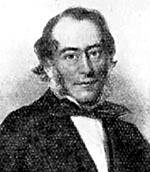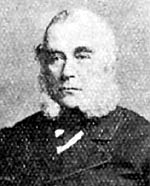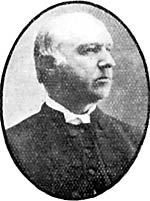WILLIAM WINDLEY was a silk throwster, and about 1853 built, and afterwards resided in the house, now the residence of Mr. J. D. Player. He was one of the principal promoters of the building of St. Jude's Church, but he will be further remembered as the donor of All Saints Church. Schools, and Vicarage, which he built in honour of his father, Mr. Thomas Windley, who was a dyer in Finkhill Street. He was further one of a band of half a dozen men, among whom were the Rev. Canon Brooks, Colonel Holden, Thomas Adams, and F. B. Gill, who when the town was largely developing, 1850-60, set themselves to provide Churches, Schoolrooms, or future building sites, for aiding spiritual work in the town. He died in 1877, aged 50.
THOS. B. SEWELL was a self-taught artizan, born about 1788, and he improved every opportunity of obtaining general, and especially scientific knowledge, assiduously, and successfully. In process of time he acquired considerable skill in mathematical, chemical, and other branches of science. His efforts in the improvement of manufactured articles are described by Mr. Felkin, (p. 315-19) Mr. Felkin's History says that "in 1831 he erected a factory at Carrington, and constructed excellent circular power machines." It is more probable that he had standings in Burtons Factory. "He drew all his own patterns, many of which were in excellent taste, embodying ideas derived from his careful study of the enrichments in Greek Architecture." It is probable that he made the gas used (p 149). He in 1837-40 took out patents for various inventions. With suavity of manner, and high integrity of character he was the object of affectionate regard. In the evening of his life he went to Australia. His gravestone in Carrington Churchyard records that he died in 1879, aged 86.
WILLIAM SPENCER was a schoolmaster, who is described in 1846 as having been "introduced to that office directly from a laborious calling," but of whom the Inspector says "the cheerful subordination of this school, the new and useful expedients of instruction adopted in it, and the selection of books and apparatus, do infinite credit to the judgment and zeal of the master."
He removed to Ruddington school, where he rendered splendid service in co-operating with the late Chas. Paget, Esq , M.P., in the mental improvement of young men. He also so arranged the lessons, that half-time children working on the land should not lose any of their instruction. There is a brass tablet to his memory in Ruddington Church. He died in 1881.

Mr A. Wells.
ARTHUR WELLS was an eminent lawyer, and Clerk of the Peace for Nottingham. He lesided for many years at Cavendish House, Sherwood. He was for some time Superintendent of Castle Gate Sunday School, and for many years one of the Deacons of that Church. He was a man distinguished for his common sense, the advice he gave leading to the settlement of disputes. Level tempered, kindly-hearted, he had considerable influence among his fellows, and that for good. He was chairman of Thomas Adams & Co., Ltd., and of other bodies. He was a great traveller, and Fellow of the Geographical Society, and Art Collector. A valuable collection of Jade Carvings he left to South Kensington Museum. He bequeathed £40,000 in charities, of which may be named £2,000 to Miss Burton's Almshouses, £6,000 to the Congregational Institute for training young ministers. £15,000 to the London Missionary Society, £5,000 to the Bible Society, etc. He died in 1882, aged 67.
MISS SARAH N. BURROWS was the mistress of the small mixed school, built in 1860, by the Rev. Canon Brooks, as an outpost, or Mission of St. Mary's—hence the name "Mission Street." She was untrained, with limited knowledge—a "Village Schoolmistress," but she had a grand influence for good on the children and their parents. She received from the Department a Certificate in 1877, and Mr. Mundella, when at the head of the Board of Education, secured for her a pension of £30. She resigned in 1881, and died in 1900.
The chimney at the gable end of the schoolroom next Woodborough Road may be regarded as a monument. It was built by Canon Tebbutt when Vicar of St. Ann's. Mapperley in those days was very exposed, and the chimney, which stood at the side, and was tied by a rod to the roof, was twice blown down. On the second occasion, a dreadfully stormy day, the attendance was small, and so the children were gathered in one class in front of the fire. An instinctive feeling came over Miss Burrows, and she moved the children, when, suddenly, crash came the stack of bricks through the roof, and fell on the spot where a minute previously the children had stood.
THOMAS UNDERWOOD was a printer in St. Peter's Gate, where the business was carried on as Kirk & Underwood. He resided many years at Carrington. His distinguishing traits of character were his thorough integrity, joined with courtesy. and the desire to be helpful to others. He was the founder of the charity called "Thomas Underwood's Charity," whereby elderly ladies of straitened means receive allowances of £10 to £30a year from the interest of a fund of £5,000 invested, which has been considerably augmented since his death. He died at Newstead Grove in 1873, aged 75.

Ald. Gripper.
EDWARD GRIPPER was a brick manufacturer, and was the founder of the Nottingham Patent Brick Co., and introduced the Hoffman continuous Kiln into the district One of the Kilns he built in 1808 has been burning ever since. He was a member of the Basford Local Board, and on its incorporation with the Borough he was made an Alderman, and became chairman of the Water Committee. In 1880-81 he was Mayor, in which year the University College was opened by H.R.H. Prince Leopold, the Duke of Albany. For 16 years he was a member of the School Board, became vice-chairman 1870-73, and was chairman thirteen years. Upwards of twenty schools were built while he was on the Board, and five or six were transferred to it on the extension of the Borough. He devoted six hours per day to public business. He was a man of great ability, especially in grasping details, inflexibly just, and with a high sense of public duty. He died in 1894, in his 79th year, and was buried in the Friends' burial ground.
THOMAS RAWSTON STAREY was a coach builder, and lived on Sherwood Rise before he, in 1861, went to live at Daybrook House. He was born at Croydon Palace, where the Starey's had lived 200 years. He was one of the first three officers who, in 1859, joined the Robin Hoods, of which he became a Captain, Mr. (afterwards the Rt. Hon.) A. J. Mundella being for a time his Lieutenant. In the Town Council he moved the adoption of the Free Libraries Act, and was for many years chairman of the Committee. He was vice-chairman of the Castle Museum Committee when it was opened by H.R.H. the Prince of Wales. He was on the first committee of the Royal College of Music, London. He was courtly in manner, and amiable in disposition. He died in 1891, aged 72, and was buried in the Church Cemetery.
CHARLES TYLDEN ONLEY WRIGHT was Managing Director of the Shireoaks Colliery Company, near Worksop, and part owner of the Steetley Lime Quarries, Worksop. For several years he occupied Mapperley Hall and Farm, but was not related to the local family of Wrights. He was a member of the Notts. County Council. As a skilled geologist he had written on the geology of the Worksop district As consulting engineer his services were in great demand. He took a prominent and useful part in the public affairs of Worksop. He died in 1900, aged 68.
GEORGE BLACKBURN was a hosiery-machine builder, who for thirty years resided on Sherwood Rise. He came to Nottingham in 1852, along with Messrs. Attenborough and Mellor, and they all became partners in the business, having previously been workmen of Messrs. Platts, of Oldham. With a thorough knowledge of machinery, and skilfulness in the use of tools, they developed superior machines, being one of the first builders of Cotton's patent, and Circular Loop-Wheel machinery. They built "Atlas Works," in Kirk White Street, and became large employers of labour, having at one time 600 to 700 workpeople. Mr. Blackburn was a member of the Town and City Council 26 years, was chairman of the Health Committee, and acted on other committees, and was an Alderman. He died in 1900, aged 75.
MRS. ELIZABETH LENNON was a widow residing at Algoa House, on the Private Road. She was a very quiet lady, but generous to a degree, her purse being always open to the poor, and to any good work of which she approved. At her own cost she built the large parish room adjoining to the Vicarage.
She died in 1001. A tablet in the church tells that Berry Gray Lennon died at sea in 1877, and has these pathetic lines added:—
"Oh let him rest in his ocean grave,
There's an angel who knows the spot.
When the fathomless caves give up their dead
Not a gem shall be forgot."

Canon Lewis.
CANON JAMES DAWSON LEWIS was Vicar of St. Ann's when it was decided to build St. Jude's Church as a district church, or chapel of ease, to St. Ann's, and he then had charge of a parish containing 22,000 souls, and was chaplain at Mapperley of the Coppice and City Asylums. He was a member of the Nottingham School Board (in 1888 its vice-chairman, Canon Richardson being chairman), and he took an active part in many social efforts, such as Friendly Societies. He was unwearied in labour, generous to the poor, willing to help on any movement designed to promote the good of the people, unassuming in manner, earnest in Gospel work, and aiming at having in his sympathies the breadth of God.
After nineteen years' work at St. Ann's he felt the need for some relief, and in 1900 he became Rector of Trowell. where he sighed for more work, and died in 1905.
Successive Vicars have been: Rev. R. C. C. B. Bardsley, now Hon. Sec. to the Church Missionary Society; Canon Walmsley, now Bishop of Sierre Leone; and the Rev. M. J. G. King.
